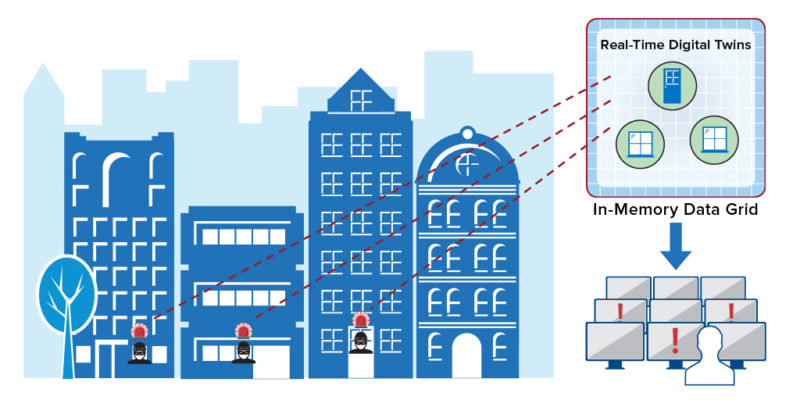Real-time digital twins offer an important breakthrough in streaming analytics that maximize situational awareness for live, mission-critical applications, such as security monitoring and disaster recovery. They can continuously track telemetry from many thousands of data sources (such as intrusion monitors and fire alarms) and respond in milliseconds. Unlike traditional stream-processing architectures, they can perform aggregate analytics in real time (instead of with offline batch processing on platforms like Spark) to immediately identify problem areas, assess the dynamic nature of a threat, and prepare an immediate, strategic response in seconds. This maximizes situational awareness without the need for personnel to manually scan data from countless data sources, attempt to integrate this information and then determine where to focus scarce resources during a rapidly evolving situation.
As a simple example, consider a “smart” city which delivers real-time telemetry to a control center from thousands of sensors distributed across a metropolitan area. Real-time digital twins can track this telemetry and intelligently analyze it for patterns of interest by making use of contextual information, such as each device’s parameters, specific location, service history, and time-ordered log of recent events. Continuous, aggregate analysis requiring under five seconds to complete can identify those sensors with the highest alerting priority and reveal patterns of dynamic changes which indicate how a threat is evolving. For example, this can show the scope of an attack or fire and the areas likely to be affected next, and it can help direct an emergency response to best contain and resolve the situation.
The following diagram illustrates how city-wide sensors can direct telemetry to real-time digital twins hosted in an in-memory computing platform, which runs the analysis algorithms and provides real-time alerts to personnel:

The key to the power of real-time digital twins is their implementation on a software-based, in-memory computing platform which provides highly scalable, memory-based data storage and integrated, data-parallel computing for performing both stateful stream-processing and aggregate data analysis. Learn more about ScaleOut Software’s in-memory computing platform for stream-processing with real-time digital twins, called ScaleOut StreamServer®, here. This product hosts application-defined, real-time digital twin models written in Java, C#, or JavaScript using the ScaleOut Digital Twin Builder™ software toolkit; learn more about this toolkit here.
